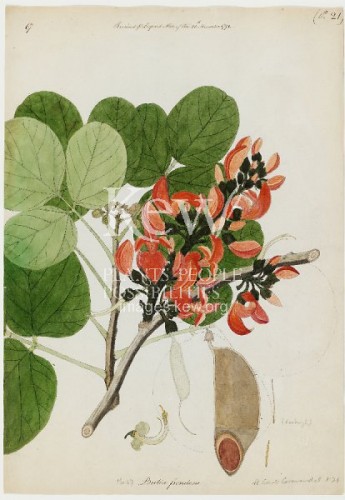The kiṃśuka is a fire: the blazing red flame that burns lovers’ hearts; a fierce conflagration in a mountain forest; sacrificial fires for the rites of the festival of Love.
Beyond its bright red hue, the kiṃśuka flower’s distinctive shape makes it the subject of striking, at times disturbing, imagery. The name is popularly derived as kiṃcit śuka iva (‘somewhat like a parrot’) because the flowers resemble the parrot’s red curved beak. They can also look like a bow, most often the bow of the god of love:
किंशुककलिकान्तर्गतमिन्दुकलास्पर्धिकेसरं भाति।
रक्तनिचोलकपिहितं धनुरिव जतुमुद्रितं वितनोः॥
kiṃśuka-kalika-antar-gatam indukalā-spardhi-kesaraṃ bhāti |
rakta-nicolaka-pihitaṃ dhanur iva jatu-mudritaṃ vitanoḥ ||
The filament inside the kiṃśuka bud that vies with the crescent moon shines like the lac-smeared bow of the bodiless god of love concealed within a red sheath.
Verse 11 in the vasanta section of the Subhāṣitaratnabhaṇḍagaram
In the sixth book of the Rāmāyaṇa we find the first of many more violent images when Rāma and Lakṣmaṇa, assailed by the magic arrows of Indrajit, “resemble flowering kiṃśukas”. To some eyes, kiṃśukas are the red welts left by the nails of a lover – sometimes vasanta himself – upon the body of his beloved. The Gīta Govinda pictures the curved red flowers as Kāma’s fingernails. Other poets take this idea further, imagining them to be the claws of a lion – the lion of spring or the lion of love – or even an elephant driver’s hook. We are into a realm quite different from the regular fire-bow-and-arrow imagery of vasanta; the kiṃśuka does not assail the lovesick with its smell, it rips them apart.
किंशुकक्षितिरुहां विलसन्तः कुड्मलाः कुटिलतां कलयन्तः।
पान्थवारणविदारणताम्राः कामकेसरिनिखा इव रेजुः॥
kiṃśuka-kṣitiruhāṃ vilasantaḥ kuḍmalāḥ kuṭilatāṃ kalayantaḥ |
pāntha-vāraṇa-vidāraṇa-tāmrāḥ kāma-kesari-nikhā iva rejuḥ ||
The buds of the kiṃśuka trees gleam as they form curves; red from ripping apart and pinning down travellers they shine like the claws of the lion of Love.
Verse 72 in the vasanta section of the Subhāṣitaratnabhaṇḍagaram
Names
The kiṃśuka’s English names – Parrot Tree and Flame of the Forest – reflect two of these associations. It is also known as Bastard Teak. In Sanskrit it can also go by the name palāśa, or parṇa (literally ‘leaf’ because of the size of its leaves, which, in one verse, pose as flowers and so lure unsuspecting bees) or vātapotha – which seems to mean ‘that which strikes the wind’. It is normally identified as Butea Frondosa.
In modern Indian languages, the kiṃśuka remains kiṃśuk or palāś in Hindi and Bengali, but also ḍhāk in Hindi. In the South, it is camatā, murukkaṉmaram, puracu, palācam, kirumicatturu, kāli in Tamil and camata or pḷāśu in Malayalayam.
Botanical description
The Pandanus database of Indian plants describes the kiṃśuka as:
A deciduous tree up to 15m high, prominent red flowers, 3-foliate leaves, gummy bark, large bright orange red flowers in clusters, grows all over India up to 1200m elevation.
The image above is from a collection of paintings of Indian flora commissioned by William Roxburgh in the 18th century – to see more from this collection and to buy prints, please go to the Kew website here


उत्तमं लेखनम् । प्रयोजनकारि लेखनम् ।